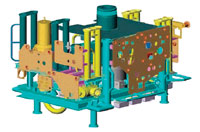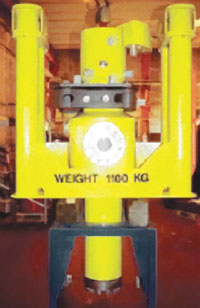 Technology from Europe: Technology from Europe:
Norway/Sweden
Multiphase flowmeter maximizes output, assists reservoir management
BHP Billiton’s Keith oil field was discovered in the 1980s, but its development was pushed into the late 1990s by a combination of mixed appraisal results and lack of area infrastructure. Output finally began in November 2000 from this small, marginal, geologically complex, North Sea field. Subsea production started after recompletion of the best appraisal well in what became the first subsea-to-subsea facility tieback in the North Sea.
Keith field’s waxy, but gassy black oil is produced to Bruce field’s (BP) Western Area Development subsea manifold via an insulated pipeline bundle. Keith’s single completion (K01) is operated from Bruce facilities via typical, subsea hydraulic systems. The K01 oil producer was completed with a 10,000-psi, artificial lift, subsea tree. Additionally, the completion was fitted with two permanent downhole pressure gauges, scale inhibitor injection and three gas lift mandrels. A Framo multiphase flowmeter (MPFM) was attached to the well’s subsea structure and downstream of the production flowline choke.
The downhole/MPFM equipment package was installed not only for well production management but also for longer-term assessment of field performance. Thus, measurement of initial Keith field performance was considered crucial to identifying future in-field opportunities. Prior to this installation, the operator had four years of experience with MPFMs in the Liverpool Bay development in the Irish Sea.
Since output began, the MPFM on K01 is credited with providing value in three areas: maximizing oil production, assisting reservoir management, and providing input for well testing and allocation. As regards maximizing oil output, the MPFM has allowed operator personnel to monitor real-time performance and optimize gas lift.
In the latter case, the meter provided immediate, accurate well response data during an optimization test that injected 2 MMcfgd to obtain a 10% rise (about 600 bpd) in oil output. Use of the MPFM data, combined with the downhole pressure gauge, has also been valuable in monitoring changes in the well productivity index. Personnel have been able to perform assessments of reservoir pressure within the well’s drainage radius.
In terms of reservoir management, a database is kept of all well instrument telemetry on a 10-min. interval for this field, which is produced under depletion drive. The arrival of near-wellbore production of the bubblepoint is noted, as is the start of water production for discrete periods following shut-ins due to host platform process trips.
On the subject of production testing and allocation, the MPFM provides an almost continuous read-out of oil, gas and water flowrates. The value of the MPFM’s datastream becomes apparent in managing the interaction of Bruce-Keith output operations. Monthly Keith well tests are difficult and time-consuming to perform in a stable manner, often running two to three days. During field life to date, a conventional separator well test has been performed only every two to three months, compared to the more ideal once per month. Fortunately, well behavior has been close to project expectations, so the low well test frequency has not hindered field management. Nevertheless, the MPFM datastream has been quite useful for comparison against conventional well test results.
 |
 |
Use of a multiphase flowmeter (above, left and right) on the single producer at the Keith field subsea installation has helped to maximize oil output and improve reservoir management. It has also served as a check on production testing and allocation.
|
|
In summation, all parties associated with the Keith development have concluded that the MPFM is integral to understanding field performance. The device has also identified some weaknesses in the host platform’s testing system that are now undergoing an engineering upgrade. Repeatability and consistency of the MPFM data has also been helpful in assessing the allocation variable between the two field’s oil
production. 
|

 Technology from Europe:
Technology from Europe:


